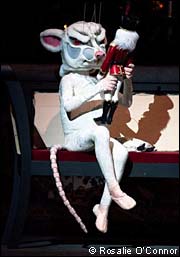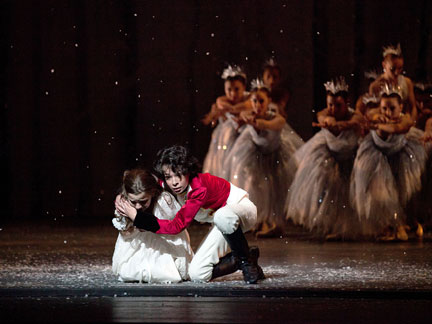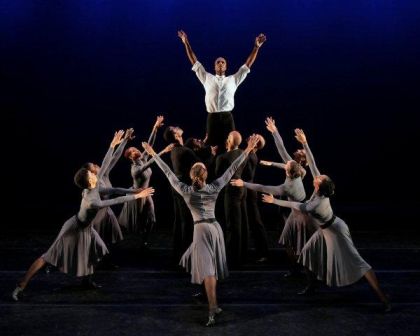foot in mouth: December 2010 Archives
Yes, ridiculous: now that all the nuts are cracked, I get around to posting these.
It was an especially bountiful Nutcracker season here in New York. Besides the glorious perennial, New York City Ballet's Balanchine production, Ratmansky mounted his very own version for ABT and Mark Morris's Hard Nut made a rare (too rare, I say) East Coast appearance.
The Ratmansky excited me so much, I hardly knew where to begin. But I began. Below, a chunk of that review. We are lucky--the ABT production will return to BAM next year, when I hope to get to some thoughts that didn't make it into this first review (like, for example, more about the choreography, which is delectable, and mainly ensemble work: a very deliberate choice, I think).
For Alexei Ratmansky's latest revelation, a deep and vivid Nutcracker, the former Bolshoi director and current American Ballet Theatre resident choreographer has absorbed influences as various as Balanchine and Mark Morris. Yet in spirit, story and choreography this two-hour drama is indelibly his own: at once goofy and wise, theatrical and musical, casually gestural and mindbogglingly virtuosic, entertaining and moving. Despite its setting in the cosily domestic Biedermeier era of 19th-century Germany, it is also thoroughly contemporary.Like many Nutcrackers, this one offers a child's-eye view of life's wonders and terrors. Like many, it reveals our heroine, Clara, stretching towards young adulthood. But its vision of this blooming is all its own - with the fantastical learning to live in peace with the real, the private with the public, the gleefully childlike with the soberly adult, in an intricate psychological design.
The ballet begins in the messy kitchen of the Stahlbaum house, where secrets are spilled and appetites cooked up. Two sassy maids show off the mincing steps they have gleaned from past parties, just as Clara (a persuasive Catherine Hurlin) will learn from the current one. She and her little brother Fritz are salivating over more immediate and childish pleasures, a tray of freshly baked sweets.
Beneath the worktable, a scene-stealing Little Mouse (delightful Justin Souriau-Levine) gnaws on a massive wedge of cheese in a foreshadowing of the larger, more ravenous vermin to come. The Stahlbaum parents steal a swoony kiss. And after everyone has left for the festivities in the living room, Drosselmeyer (Victor Barbee) enters. His wavy locks signal his Romantic standing in this stalwartly bourgeois milieu; so does his latest creation, the bewitched nutcracker doll, which he will bestow on his favourite godchild along with his invisible gift for fantasy.
The Little Mouse (Justin Souriau-Levine) eying his nemesis. Photo by Rosalie O'Connor for ABT.
Ratmansky sounds the note of romance lightly but consistently: the life-sized dolls with which Drosselmeyer entertains the guests come in male-female pairs, and Clara's girlfriends pant after the imperious wizard as if he were Elvis. So the winter wonderland music that swells in the wake of the battle between the mice and the toy soldiers anticipates not only the coming snow but also Clara's feelings for the boy inside the Nutcracker shell whom she has saved (a sweetly shy Tyler Maloney).
Yet the choreographer does not make the Soviet mistake of having Clara instantly shed her child heart and fall lustily in love, at which point Candyland would only bore her. Rather, she and the boy mix awkward hugs with snowball fights.
The snow grows dangerous. Photo by Erin Baiano.
When their imagined older selves appear, the children waltz alongside them for as long as they can keep up. (On opening night, a buoyant and slippery Gillian Murphy and an impetuous David Hallberg did the honours as mature princess and prince; at the Friday matinee, it was a coltish Paloma Herrera with a somewhat shell-shocked Cory Stearns. [Ed. note, just promoted to principal--and yet he is hardly used to being a soloist!])
The Sugar Plum pas de deux, the apotheosis of this dream romance, sustains a goofy delirium beside a more traditional nobility. Likewise, Ratmansky injects a quartet of begoggled bumblebee men into the unfolding mass of waltzing flowers, models the Russian dancers after the Three Stooges, and has Mother Ginger's tiny charges do a squat and sassy chain-gang dance with waggling heads and slapping feet (it perfectly becomes them).
He has a special gift for idiosyncrasy, which he celebrates with every low-key, handmade moment and every child - the production abounds in them - allowed his or her fervour and force. (British set and costume designer Richard Hudson brilliantly complements this vision with individually detailed costumes in outlandishly gorgeous hues.)
For the coup de theatre of the Ratmansky Nutcracker--the dangerous snow scene, with hapless Siren Flakes--click here.
To all those Brooklyn parents of youngish children, this is a great Nutcracker for kids--and not just because there are a lot of them. As I suggest above, Ratmansky allows his little charges a buoyant ferocity and goofiness that are the vernacular of children. At the one matinee I got to, a Russian mother behind me who had come down from Ithaca was fretting at intermission over whether she had brought her 5-year-old son to the right Nutcracker--should she have done the Balanchine instead? But at the final bows, she reported it was the first Nutcracker (of four) her son had stayed awake for in the second act. Of course, this may only be because he is now a year older...
The chief new pleasure of this year's Hard Nut
was Morris's debut as the Homer-Simpson-like Dad Stahlbaum: myopically trying to fulfill his duty as head of the clan when he's most definitely its tail. Everyone was fantastic, in fact--that's one thing you can count on in a Morris production. I didn't have the space here to write much about the dancers, unfortunately.
More than most American versions of The Nutcracker, Mark Morris's campy, thoroughly hopeful take is a love story - about how random acts of horniness in a newly liberated yet still ticky-tacky America might inspire a child to something genuine when she grows up (quickly, of course).Any decent Nutcracker deftly establishes the real-world setting from which its nightmares and dreams will spring. Morris's 20-year-old tale takes place wherever the defanged Nutcrackers that this Nut fondly despises might tinkle: elevators, supermarkets or at the Stahlbaum Christmas party circa 1970. The guests, in pompadours and polyester disco duds, are already washed up. It makes you want to giggle and moan. The partiers bump and grind and perform other mildly naughty moves on one another - Morris, like Balanchine, has one intrigue tumble after another - but, as Tchaikovsky's light music (too light on opening night) intimates, they know to keep themselves in hand.
Mr. Stahlbaum (played for the first time by the inimitable Mark Morris) leads his guests in Xmas carols. Photo by Stephanie Berger for BAM.
Our heroine Marie (a subtly sincere Lauren Grant) knows nothing. In a world of comic-book black and white, blaring Christmas red and green, and lewd innuendo, the girl wears pink and misses all the jokes. But she intuits what all the grown-ups, except the magnetic Drosselmeier, only grope towards.
Click here for how Morris saves the second half of The Nutcracker from the usual extended coda.
Because Alvin Ailey American Dance Theater has tended to extrapolate badly from its founder's aesthetic and ethos, I forget every year what a strong craftsman Ailey was. Even when he was tired, the work had merit. Revelations is always my first reminder of his craft--and, no, he wasn't tired for that--followed this year by Cry, Night Creatures, and the final section of Three Black Kings. In fact, Ailey produced relatively little dreck. (I'd put Memoria on that list and maybe Flowers and most of The River.)
In the three reviews I wrote for the Financial Times on the current season (through January 2), I found myself wanting mainly to write about the Ailey contribution even when there was a premiere on the program.
Here is my review of the best premiere of the season, Christopher Huggins' Anointed. I situate it in terms of the Revelations legacy as I see it:
At Revelations on Friday, the gloriously craggy singer Ella Mitchell belted out the gospels while Judith Jamison in conductor mode coaxed a low, spooky sound from the chorus and students from the Ailey school dashed into the auditorium to mirror the drama onstage.
When the dancers slapped the air with their fans and threw back their heads to "Rocka My Soul", the audience jumped up, ecstatic. Though they always rise for Revelations - it has become part of the ritual - this time the packed house was possessed.
Whether Revelations cracks the fourth wall or not, its mix of blood memory, pilgrim's progress, popular music and populist faith has served as lodestar for the company repertory, though most works isolate a single strand from those that Revelations miraculously entwines.
The five-week City Center engagement includes snapshots of the Harlem Renaissance (Matthew Rushing's Uptown) and spontaneous subway dramas (Camille Brown's Groove to Nobody's Business); glorified dance parties (George Faison's Suite Otis and the team effort Love Stories); works to Ellington and Gillespie, played live by Wynton Marsalis and company; and spiritual journeys, the most recent of which surely contributed to the glowing mood on Friday.
Ailey alumnus Christopher Huggins's Anointed creates its fervour via the swift, seamless partnering, stretched limbs and curving torso, and constant motion of contemporary ballet. The idiom risks soporific sameness and relentless emotionality, and Anointed's Moby soundtrack - like light at the end of the tunnel minus the tunnel - certainly pushes in that direction.
From left, the gorgeous women of Ailey: Rosalyn Deshauteurs, Olivia Bowman-Jackson, Ghrai DeVore, and Demetia Hopkins in Christopher Huggins's Anointed. Photo by Paul Kolnik.
But the choreography is so enlivened by flight - the women gathered into the men's arms like flower buds or suspended overhead like birds- and so awake to human dignity that it escapes a banal end....
Click here for the whole Anointed review.
And here is a review of the season's opening night, with the company premiere of artistic director in waiting (as my esteemed and witty colleague Roslyn Sulcas has put it) Robert Battle's manly Hunt. But again Revelations distracted me, getting me thinking about what could possibly have been so misunderstood about Ailey's aim to justify such awful contributions from his peers and progeny (with the big exception of Ronald K. Brown).
The company is in the mood for self-love. Last season it celebrated artistic director Judith Jamison's 20th anniversary with a premiere dedicated to her "spirit" and a greatest hits compilation of works commissioned during her reign. Now it is throwing a year-long 50th birthday party for the dance to which it owes its reputation: the founding choreographer's Revelations. There will be live accompaniment on several occasions, a version for a cast of 50, and a documentary by Judy Kinberg of Dance in America renown that prefaces each performance.It is hard to have an experience that has already been memorialised. By the time the curtain rose on the dancers on the glittery opening night, I only wanted to compare them with their screen versions. But I realised why Ailey dancers can reach outspread hands to heaven, while contestants on So You Think You Can Dance cannot. Even Ailey's most overused gestures come with an aura of modernist faith. His belief in the distillation of emotion and story into spare lines imposes a restraint on his choreography - a sensual interiority - that saves it from kitsch.
But this saving grace depends on the dancers' delivery. Too often.....
Here is the whole opening night review, for your delectation.
Finally, with Three Black Kings, revived in full for the first time in three decades, I am fully justified in going on about Ailey.
Three Black Kings has lain dormant almost since Alvin Ailey created it for a massive Duke Ellington celebration that he organised in 1976. The choreographer had made dances to the Duke from the beginning - Blues Suite, Reflections in D and a suite of works Ellington commissioned to accompany My People for the Emancipation Proclamation's centenary in 1963. But when the composer died in 1974, Ailey outdid himself, creating eight pieces to his music in two years.
Saluting the King (Martin Luther, danced by Glenn Allen Sims). Photo by Paul Kolnik.
Three Black Kings is the genius jazzman's last composition, completed by his son Mercer after his death. It is not his best work, nor Ailey's. But both are good enough to justify this belated revival, especially when Wynton Marsalis's Jazz at Lincoln Center Orchestra is in the house, as it was last week. In fact, the dance dwarfed everything else on Wednesday night: Billy Wilson's Winter in Lisbon, a paean to 1940s nightlife that drowned Marsalis's smoky, then bleating trumpet in a din of razzmatazz moves; Ulysses Dove's Episodes, a portrait of mean-spirited anonymous sex; and artistic director-designate Robert Battle's solo In/Side, its appealingly gawky vulnerability undermined by a repetitive structure.
For the first black king, the Nativity wise man Balthazar, Ellington alternates propulsive conga drum with piercing clarinet. To the drums Ailey sets bare-chested men whirling like dervishes. To the reed, the dancers bow luxuriously before their demigod king (Jamar Roberts, perfectly typecast). But the music's lyrical solos do not merely announce the presence of royalty; they are a clarion call to a new order. Why else would the Magi "traverse afar"? Ailey sticks to Balthazar before he leaves home.
For Solomon, king number two, Ellington focuses not on the sage judge but on the lover of 700 wives and 300 concubines. So Clifton Brown comes out in a loincloth....
For the whole Black Kings review, click here.
AJ Blogs
AJBlogCentral | rssculture
Terry Teachout on the arts in New York City
Andrew Taylor on the business of arts & culture
rock culture approximately
Laura Collins-Hughes on arts, culture and coverage
Richard Kessler on arts education
Douglas McLennan's blog
Dalouge Smith advocates for the Arts
Art from the American Outback
Chloe Veltman on how culture will save the world
For immediate release: the arts are marketable
No genre is the new genre
David Jays on theatre and dance
Paul Levy measures the Angles
Judith H. Dobrzynski on Culture
John Rockwell on the arts
innovations and impediments in not-for-profit arts
Jan Herman - arts, media & culture with 'tude
dance
Apollinaire Scherr talks about dance
Tobi Tobias on dance et al...
jazz
Howard Mandel's freelance Urban Improvisation
Focus on New Orleans. Jazz and Other Sounds
Doug Ramsey on Jazz and other matters...
media
Jeff Weinstein's Cultural Mixology
Martha Bayles on Film...
classical music
Fresh ideas on building arts communities
Greg Sandow performs a book-in-progress
Harvey Sachs on music, and various digressions
Bruce Brubaker on all things Piano
Kyle Gann on music after the fact
Greg Sandow on the future of Classical Music
Norman Lebrecht on Shifting Sound Worlds
Joe Horowitz on music
publishing
Jerome Weeks on Books
Scott McLemee on books, ideas & trash-culture ephemera
theatre
Wendy Rosenfield: covering drama, onstage and off
visual
Public Art, Public Space
Regina Hackett takes her Art To Go
John Perreault's art diary
Lee Rosenbaum's Cultural Commentary




Recent Comments